Ship of the Line Poltava, Peter the Great’s galley, St.Nataliya, (flagship of Peter the Great) and the Elephant.
The three models depicted here were all employed in the opening years of the 18th Century in the Great Northern War between Sweden and Tsar Peter’s upstart navy.
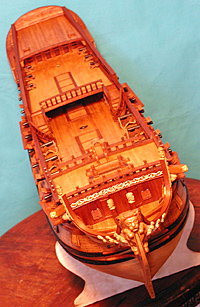 http://www.shipmodels.ru/images/poltava/poltava3.jpg
http://www.shipmodels.ru/images/poltava/poltava3.jpg
During the Great Northern War, Tsar Peter the Great attempted to penetrate to the Baltic sea; he conquered the uppermost portion of the Gulf of Finland and founded there the fortified city of St. Petersburg, which became the new capital of Russia. The proximity of the new metropolis to Finnish soil has for the three centuries elapsing since then had a profound effect on the vicissitudes of Finnish history and on the borders of Finland, both when she was part of Sweden (until 1809) and when she was part of Russia (1809 to 1917), as well as after she gained independence (from 1917).
The still existing naval base and fortress of Kronstadt was also founded in 1703. From 1704, Russia controlled all of Ingria, and, in subsequent years, all of the Baltic lands, which are now independent countries. The conquest of Finland was begun in 1710 after the fall of Vyborg; Helsinki (Sved. Helsingfors) and Turku (Swed. Åbo) were taken in 1713, and the fate of the rest of Finland was sealed during 1714. The Swedish-Finnish army suffered a crushing defeat in winter 1714, which made the inland areas accessible to the Russian infantry and cavalry. During the same summer, detachments of the Russian Navy and Archipelago fleet broke into both the Baltic to the west and the Gulf of Bothnia to the north after the battle of Hankoniemi mentioned below.
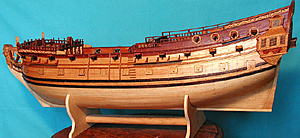 http://www.shipmodels.ru/images/poltava/poltava3.jpg
http://www.shipmodels.ru/images/poltava/poltava3.jpg
This model of Poltava is being built for the 300th anniversary of St. Petersburg and is expected to be ready by the end of 2002. Only precious types of wood are used in the creation of the model. These photos show the status of the model as of 21 April 2002. The scale is 1:48, or one inch on the model equals four feet of the real ship. No price is given at this time, but one can only imagine the cost of this exquisite museum piece. Courtesy, Ship Modeling Club of St.Petersburg.
In 1710 Russia's first three 50-gun ships were launched at the shipyards of New Ladoga and Olonets. This was an important event, since, following the Prut Treaty and the eradication of the Azov fleet, the centre of Russian naval activity had shifted to the coast of the Baltic Sea. Within two years the 54-gun ship Poltava, was launched from the Admiralty yard, followed by the even larger warships Saint Catherine, Shlisselburg, Narva and Ingermanland.
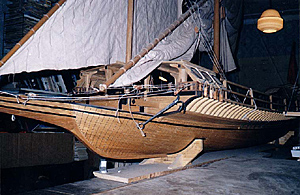 http://www.shipmodels.ru/images/gangut/gangut2.jpg
http://www.shipmodels.ru/images/gangut/gangut2.jpg
Galley Fleet
Here is a model of a galley similar to those that were employed by Peter the Great’s navy in the second decade of the 18th century. This particular vessel was the St.Nataliya, the personal galley of the Russian emperor. At the scale 1:12, the model measures over 13 feet long. Notice that using different woods rather than painting demonstrates the color contrasts, so one can admire the true-to-life construction techniques of the model maker. The predominate wood employed is oak. Planks are fastened on ribs just as in the real ship. It is typical of those galleys that triumphed in the sea battles of the Great Northern War. Courtesy, Ship Modeling Club of St.Petersburg.
The galley fleet founded by Tsar Peter the Great achieved its first victory ever over the Swedish Coastal Fleet at the battle of Hankoniemi , transliterated as “Gangut” in the Russian, on July 1714. This victory gave Tsar Peter's navy free passage to the west into the Baltic Sea and to the north into the Gulf of Bothnia. In honor of the victory, the name Gangut (from 'Hangöudd', the Swedish form of Hankoniemi) was thereafter reserved as the name of major Russian (and later Soviet) battleships. One famous example is from the Battle of Navarino, in the Turk-Russian war of 1828-29, another is the lead ship in a class of four dreadnoughts laid down in 1914. The Gangut of 1914 became the “October Revolution” after the political winds of change in 1917.
In September 1714, the treacherous shoals and storms of the Gulf of Bothnia caused the first major casualties to the same fleet. Twenty-eight ships of different types, i.e. more than a third of the entire fleet were destroyed in the coastal waters and went down with all hands. The casualties in ships and men were according to the diary of Peter the Great, "greater than in the bloody battle of 'Gangut'".
A galley had ten to twenty seamen and as many as 500 infantrymen and oarsmen. The armament consisted of six to eight 6-pound cannons or swivel guns. Galley warfare actually consisted of infantry tactics transferred to the sea, especially since the range of the Russian cannons was shorter than of those in the Swedish galleys. It was all that the Russian seamen could do to grapple the enemy vessels and have the galley infantry attack, supported by musket fire and grenadier-thrown hand grenades, finish off the job with 'cold arms', swords and bayonets. The crew of a half galley was half that of a galley (i.e. 250 men), and the crew of a scampavoya (from the Italian phrase, “ scampare i via”), the most common ship type in the 1714 campaign, was half again that of a half galley. The crew of the smallest ship type, the brigantine, was half the crew of a scampavoya. Most, sixteen in fact, of the destroyed ships recorded by Apraxin and Golowin were scampavoyas.
Peter the Great had acquired his first galleys from Holland as a result of his famous sojourn in Holland and England studying the ways of the West, but the main part of the rapidly assembled galley fleet was built in Russia and in lands conquered by Russia. Consequently, Peter founded a school for shipwrights at the Voronets shipyeard in 1703, in Reval (Tallinn) in 1703 and in Kronstadt in 1719, but at the same time, galleys were built for the Russians at shipyards along the occupied Finnish coast
In May-June of 1714 General-Admiral Apraksin moved his entire galley fleet, consisting of 99 scampavias (small galleys), to Helsingfors accompanied by the fleet of Rear Admiral Pyotr Mikhailov, which included nine ships of the line and five frigates. The two Russian fleets separated off Helsingfors, Peters flotilla heading toward Revel with the larger force, while Apraksin’s galleys made for Abo (modern Turku).
However, on the approaches to Gangut Peninsula the Swedish squadron of Admiral Gustav Wattrang blocked Apraksin's ships. The ships arriving at Revel had considerably reinforced the Russian fleet, but when an epidemic of plague broke out among his seamen, Peter could not risk a decisive battle with the forces of Admiral Wattrang. Apraksin's galley fleet would have to break through to Gangut on its own.
Peter made for Tvarminne, where Apraksin's galleys were concentrated, on the eastern coast of the peninsula. Upon his arrival the Tsar ordered a portage of several scampavias across the narrow Isthmus of Gangut in order to confuse the enemy. Upon learning of the Russian portage, Wattrang decided to send out a small unit under the command of Schoutbynacht Nils Ehrenskold. At the same time the Swedish admiral divided his main forces. A detachment of eight ships of the line and two cruisers under Vice-Admiral Lillie set out for Tvarminne to attack the Russian galleys. Almost complete calm slowed the progress of the Swedish fleet, and Peter was quick to take advantage. On the sunny morning of 26 July the vanguard of the Russian galley fleet passed by Wattrang's ships still lying off the coast and blocked Ehrenskold's unit in the skerries west of Gangut. Wattrang then towed his ships farther from the coast and joined Lillie.
However, the Swedish admiral could not aid Ehrenskold’s unit, which had taken a defensive position at the end of Rilaks Fjord. The Russian ships rushed to the attack. Ehrenskold had the advantage in artillery but was inferior in strength. In the course of the battle all the Swedish ships were captured. The 18-gun Elephant, six galleys and two skerry boats became trophies of the Russian fleet. Rear Admiral Ehrenskold was himself taken prisoner.
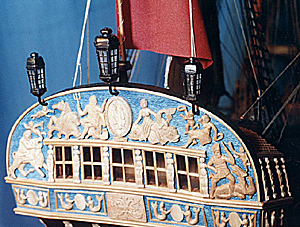 http://www.shipmodels.ru/images/elephant/elephant2.jpg
http://www.shipmodels.ru/images/elephant/elephant2.jpg
Here is a 1:48 scale model of the Frigate Olephant, from the year 1705. Olephant was the first frigate capable of carrying 18-pounder cannon. It is not the same “Elephant” that was captured as a prize from Sweden (described below). Rather this ship is of Russian origin. It was the first ship capable of carrying cannon throwing 18-pound shot by virtue of Peter the Great designing 18-pounders light enough to be mounted on board. This ship played an important part in the Russian victory at the battle of Gangut, described below. The model is about 40 inches overall length and the asking price is $5000. Courtesy, Ship Modeling Club of St. Petersburg.
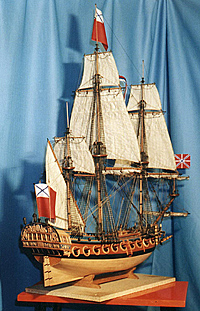 http://www.shipmodels.ru/images/elephant/elephant3.jpg
http://www.shipmodels.ru/images/elephant/elephant3.jpg
This is a close-up of the transom, emphasizing the scrupulous attention to detailing the relief carvings. You can even see through the clear glass panes of the commander’s windows to the interior of his cabin. Perhaps you might discover him poring over the sea charts at his desk. Courtesy, Ship Modeling Club of St.Petersburg.
The Swedes attempted to strengthen their position in the waters of the Aland Archipelago. However, the attempt resulted in defeat for Sweden. At the end of July 1720 near Grengam Island the galley fleet of General Mikhail Golitsyn engaged the detachment of Vice-Admiral Eric Sjoblad. Sixty-one Russian galleys and twenty-nine island boats set out against a Swedish ship of the line, four frigates and several smaller craft. Yielding to the enemy's superior artillery power, Golitsin's fleet retreated to the skerries. The Swedes started in pursuit of the Russian vessels, but Golitsyn, a shrewd and experienced officer, enticed the enemy into a disadvantageous position and seized his opportunity. The granite coastal boulders, in effect, came to Golitsyn's aid; two Swedish frigates were run against them, seized and boarded. The Swedes realized their mistake and began to retreat, but it was already too late. The Russian galleys chased the Swedish vessels and in a savage fight succeeded in defeating two more frigates. An attempt was made to overtake the flagship of the Swedish force, and Admiral Sjoblad himself was fortunate to escape on the damaged 52-gun Pommern.
In 1721, the final year of the Great Northern War, Russian galleys ravaged towns along the coast of Sweden in a series of raids. It was now clear that the Kingdom of Sweden was no longer the dominant power in the Baltic Sea, a position the Swedes had enjoyed since the days of the Vikings.
Mercury, 20-gun brig

Oil painting of the action between Russian Cutter MERCURY and Swedish Frigate VENUS on May 21, 1789. By A. P. Bogoliuboff, 1851. Art collection in the Central Naval Museum, St. Petersburg. This is not the Mercury represented by the model, but an earlier vessel so-named. The story of this Mercury is included as a colorful episode in Russian naval lore.
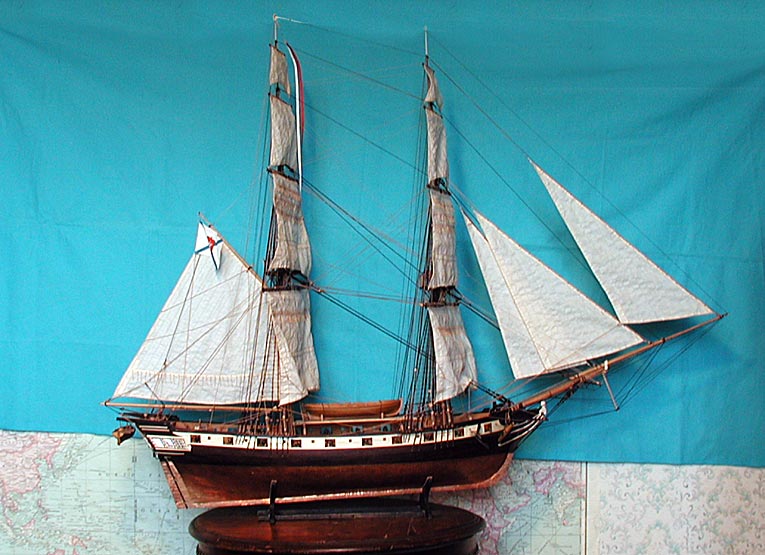 http://www.shipmodels.ru/images/mercury/mercury2.jpg
http://www.shipmodels.ru/images/mercury/mercury2.jpg
Here is a model in 1:30 scale of the 20-gun brig Mercury (one inch on the model equals 2.5 feet of the original). The model was built in the exact same manner as the actual warship. The guns were turned from bronze on a lathe, the shrouds were hand knitted. The model measures over 44 inches in length. The price is negotiable with the artist. It is this ship that is described in the segment dealing with the Russo-Turk war of 1828-29. Courtesy, Ship Modeling Club of St.Petersburg.
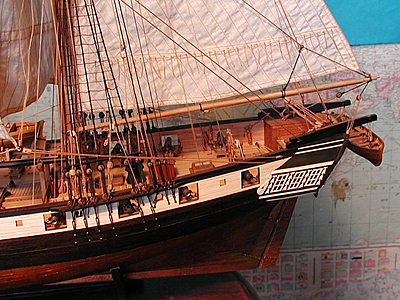 http://www.shipmodels.ru/images/mercury/mercury4.jpg
http://www.shipmodels.ru/images/mercury/mercury4.jpg
In this closer view, you can see that in this case, instead of leaving the model entirely unpainted, there is a thin varnish of white and black on the hull sides, as in the original. This is applied more as a wash so it is translucent allowing one to admire the underlying contoured plank-on-frame hull construction. The bottom is finished in copper tone to indicate the protective sheathing. Such fine details as the independent deck planking, the tackle for launching the skiff, are all displayed.

Here is another painting of the Mercury in action, this one in the Russo-Turkish Naval actions on the Black Sea forty years after the dauntless actions of the first Mercury.
18th Century Decisions
In the 1780s, compelled to wage war on two fronts, the Russian military command was faced with many difficult decisions. The bulk of Russia's forces were busy fighting the Ottoman Empire in the south, and consequently the army did not have a large ground force to dispatch to Finland. In place of army troops, it was decided that Russian seamen would have to carry the battle to the Swedish land and sea forces. The campaign of 1789 was marked by the victories of the 22-gun craft Mercury under the command of Lieutenant-Commander Roman Crown. While patrolling the coastline of Bornholm Island on 29 April, the Mercury came upon, attacked and captured the 12-gun Swedish tender Snapupp.
Then, on 21 May in Christians Fjord, the Mercury approached and began firing upon one of the largest of Sweden's frigates, the 40-gun Venus. Taken by surprise and unable to withstand the Mercury's barrage, the captain of the Venus ordered a retreat. However, a sudden calming of the winds and the presence of more Russian ships at the fjord's entrance prevented escape and compelled the Swedes to strike their colors; the Venus and its crew of 302 surrendered to Captain Crown. Having captured two enemy vessels within a period of just three weeks, Crown was awarded the Order of St. George and given command of the captured Swedish frigate. The Venus became part of the Russian fleet and, in accordance with naval tradition, retained its name.
The reverses of 1789 did not discourage Gustav III. The following spring, having assembled the forces of Sweden's army and fleet, he set sail once more against Saint Petersburg. General-Admiral Duke Carl was sent to eliminate Admiral Chichagov’s squadron, which had wintered in the harbor at Revel. The Swedish king himself headed the galley fleet, while General-Admiral Duke Carl approached Revel with 26 ships of the line and large frigates armed with 1,680 cannon. Chichagov, preparing to meet the enemy in the harbor, formed a battle line made up of ten ships of the line and the Venus.
With twice as many ships as the Russians, the Swedes attacked on 2 May. Duke Carl was confident of success, but his hopes were short-lived. One after another, the Swedish ships passed in front of the Russian line and drew intense fire from Russian gunners. The first five enemy vessels were heavily damaged and one-the 64-gun Prinse Carl-lost its helm and rudder to Russian cannon fire and surrendered. Carl ordered the last six vessels to turn back immediately. During the withdrawal and consequent panic, two large Swedish warships became grounded on a shoal. The Swedes could not extricate the 60-gun Riksens Stander and set it afire to save it from falling into enemy hands. In order to dislodge the second ship, the Tapperhet, the vessel's buoyancy had to be increased by throwing 42 of its cannon overboard into the harbor. Swedes lost 652 seamen in the battle, 520 captured. Chichagov's losses were 8 killed and 27 wounded.
It is somewhat difficult to estimate whether the model shown above is actually the Mercury of the 1780s or a very similarly configured and armed namesake ship that played an honorable part on the Black Sea during the Russian-Turkish War of 1828-1829. My inquiries to the ship modelers of St. Petersburg were not answered in time to amend this article. In any event, judging from the
On the later occasion, the Turks had been taking advantage of the restraint shown by Vice-Admiral Alexey Greig, commander-in-chief of the Black Sea Fleet, and three times were able to enter the Black Sea without encountering Russian resistance.
One such incursion resulted in the capture of the Russian 36-gun frigate Rafail. On 12 May, off the coast of Anatolia, six Turk ships of the line, plus two frigates, five corvettes and two brigs surrounded the Rafail and took her by surprise. There was nothing else for the Rafiail’s commander, Captain Semyon Stroynikov to do but to surrender his vessel to the Turks. Such was not the fate of Lieutenant-Commander Alexander Kazarsky, commander of the 20-gun brig Mercury. The 130-gun Selimier, flagship of the Kapudan Pasha, and the junior flagman's ship of the line pursued the slow-moving brig Mercury. The Turks had ten times the cannon power of Kazarsky's ship, and yet the Mercury skilfully fended off Turkish attacks for four hours. In the end the enemy relented, leaving Kazarsky's ship still afloat. The Mercury, although heavily damaged, survived to be awarded the ensign of St. George.
Sloop Neva
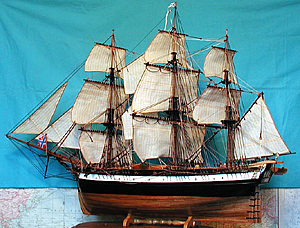 http://www.shipmodels.ru/images/neva/neva2.jpg
http://www.shipmodels.ru/images/neva/neva2.jpg
Neva was one of two sloops that took part in the first Russian circumnavigation of the earth in 1803 - 1806. At 1/48 scale, the model measures four feet in length. Note the light coating of white and black on the hull is translucent so that one can see the wood grain beneath as well as the fine details of the assembly, in the identical fashion as the original. Courtesy, Ship Modeling Club of St.Petersburg.
The first Russian circumnavigation expedition was a consequence of the endeavors of the Russian-American Company. Under consideration by Catherine the Great, the voyage was interrupted by the Russian-Swedish War, in which the leader of the planned expedition, Commodore Grigory Mulovsky, was killed. Ivan Kruzenstern, a young officer who had served with Mulovsky, proposed to dispatch ships from Kronstadt to the coast of Russian America. The directors of the Russian American Company favored Kruzenstern’s concept, and it was agreed that the merchants would pay half the expenses of the expedition. Alexander I also agreed to the expedition and placed Lieutenant-Commander Kruzenstern in command of the sloop Nadezhda. Lieutenant-Commander Yury Lisyansky became commander of the expedition's second vessel, the sloop Neva. Shelekhov's son-in-law, Nikolay Rezanov, chamberlain of the Imperial Court at St. Petersburg, was aboard the Nadezhda and, as one of the owners of the Russian American Company, was interested in establishing trade relations with Japan.
In late summer of 1803 both sloops left Kronstadt and followed the same route to the Pacific, sailing around Cape Horn. After passing the Marquesas and Hawaiian Islands, the courses of the Neva and Nadezhda diverged. The Neva headed for Russian America and the Nadezhda for Petropavlovsk-Kamchatsky. Lisyansky made a detailed geographical description of the Aleutian Islands, and Kruzenstern explored and mapped the eastern and northern coasts of Sakhalin. Kruzenstern and Rezanov visited Nagasaki; however, they found the Japanese unwilling to negotiate trade agreements with Russia. Lisyansky sailed on to Macao with a load of furs, and there the two sloops rejoined.
From Macao the Nadezhda and Neva sailed to Canton and then headed for the Cape of Good Hope. After three years the seamen returned home to Russia where their recorded commentaries served to inspire future seafarers.
Battleship Slava 1916
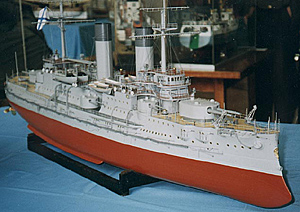 http://www.shipmodels.ru/images/slava/slava2.jpg
http://www.shipmodels.ru/images/slava/slava2.jpg
A 1:100 scale model of the Slava, which won numerous gold awards in competitions throughout Russia. This model is so true to life that one has only to photograph it by itself with a seashore background and it would be indistinguishable from the genuine battleship. Slava was 397 feet long, making for an impressive model four feet in length. The real ship four twelve-inch guns in fore and aft turrets for her main battery and a secondary armament of 12 six inch guns with many smaller caliber rifles. Courtesy, Ship Modeling Club of St.Petersburg.
Russian Battleship SLAVA engaged with German warships in Moonsund Strait. October 4, 1917. Oilcolor painting by G. V. Gorshkov, 1947 from art collection in the Central Naval Museum, St. Petersburg.
The Slava is the only member of the Borodino class of six battleships to have made a name for itself. The class as a whole suffered a dishonorable ending. In theory the Borodinos, all completed between 1903 and 1905, were derived from the French built Russian battleship Tsessarevitch, which was handed over by France in 1903 when it joined the Russian fleet. The Russians, however, modified the design so that instead of the intended 12,915 tons, the displacement increased to 13, 516 tons, whereas the power decreased from 16,500 to 16,300 hp. The net consequence was to reduce the speed by at least two knots so that instead of 20 knots it could only reach a maximum of 17.8. This may seem trivial, but recall that most of the Japanese battleships at Tsushima could go 1.5 knots faster; it is a critical difference when faced with such maneuvers as “Crossing the T”.
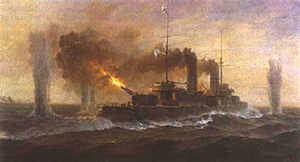 http://www.museum.navy.ru/images/mf-6.jpg
Slava was the sixth and last completed of the class, being commissioned in 1905. Because she was finished too late, Slava did not share in the ill-starred long voyage with her five sisters from the Baltic station to meet their end at the Battle of Tsushima Strait. The only one that survived that battle was the Orel, which surrendered, was repaired then served in the Japanese Navy under the name Iwami.. Slava served in the Baltic Sea until the outbreak of World War I .
http://www.museum.navy.ru/images/mf-6.jpg
Slava was the sixth and last completed of the class, being commissioned in 1905. Because she was finished too late, Slava did not share in the ill-starred long voyage with her five sisters from the Baltic station to meet their end at the Battle of Tsushima Strait. The only one that survived that battle was the Orel, which surrendered, was repaired then served in the Japanese Navy under the name Iwami.. Slava served in the Baltic Sea until the outbreak of World War I .
The Baltic port of Riga was the extreme right anchor of the Russian land defense line, which ran roughly east and west along the Dvina River. In late July, 1915, the German Command decided to transfer half its fleet to the Baltic in order to attempt a breakthrough towards the Gulf of Riga and outflank the Russian positions from the sea. The objective at this juncture was to destroy the Russian fleet anchored there. Preceded by a swarm of minesweepers, an armada under the command of Vice-Admiral Eggard Schmidt consisting of fifteen German battleships, three battle cruisers, eleven cruisers and fifty-six destroyers advanced on Irben Strait. The relatively outdated Slava, supported by the armored gunboats Khrabry and Grozyaschy, held this armada at bay in the strait, repulsing numerous efforts to break through the minefield. On the night of August 4, Schmidt sent into the Gulf his newest large destroyers, V-99 and V-100. The Russian destroyer Novik challenged their passage. In the short battle that ensued, the Novik damaged both German ships, driving V-99 into the minefield where she sank after striking a mine. The Slava was forced to yield to the superior firepower and maneuverability of the German dreadnoughts Nassau and Pozen, which forced her to the side and entered the Gulf of Riga. The Germans were subsequently fought to a stalemate, leaving the bulk of the Russian ships unscathed and failing to remove the minefield.
This situation changed in August of 1917 when the Seventh German Army took the offensive, capturing Riga in September, negating the successful Russian naval effort thus far. The Twelfth Russian army retreated toward St. Petersburg. In order to reinforce their troops at Riga, the Germans determined to attempt an amphibious assault on the islands guarding the straits. During the German combined assault on the Oesel and Moon Islands shielding the entrance to the Gulf of Riga, named Operation Albion, the Slava encountered the German dreadnought Konig on 17 October 1917. The Konig inflicted such heavy punishment on the Slava that the latter had to be finished off with a torpedo.
The Submarines Typhoon, Akula
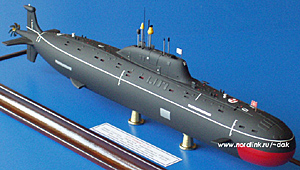 http://www.nordlink.ru/~dak/images/submarines/971.jpg
http://www.nordlink.ru/~dak/images/submarines/971.jpg
This 1:200 scale model of an Akula class SSBN demonstrates that not all contemporary submarine models have to be so uninteresting. While models of the US Los Angeles or Ohio class “boomers” appear flat and dull, the detail only visible as etched recessed lines in the surface, the Akula contains many projections that enhance the looks of the model. . Model image courtesy of Pomorsky Souvenir. The model maker is the premier producer of sub models in the Russian Federation. They are based in Severodvinsk. Russia, the home of the shipyard that designs and manufactures the real subs.
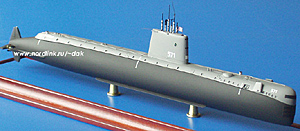 http://www.nordlink.ru/~dak/images/submarines/Nautilus571.jpg
http://www.nordlink.ru/~dak/images/submarines/Nautilus571.jpg
This model of the pioneering American atomic propulsion sub, Nautilus, from 1955, also shows some interesting details not conspicuous in the unadorned US Navy “Sturgeon” class model, likewise in 1:200 scale (shown below).
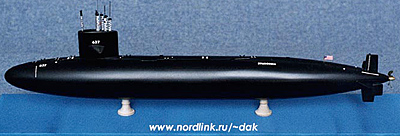 http://www.nordlink.ru/~dak/images/submarines/Sturgeon.jpg
http://www.nordlink.ru/~dak/images/submarines/Sturgeon.jpg
Akula was a new-design submarine, the steel-hulled contemporary to the titanium 'Sierra' class, but with a primary role of strategic strike using SS-N-21 cruise missiles. Notwithstanding the cruise missile capabilities against enemy cities and land emplacments, they are utilized as general-purpose attack submarines, and must be considered the best Russian SSNs in service - but still lag behind USN subs. There have been two upgrades: 'Improved Akula' and 'Akula-II'.
Improvements included better silencing and improved automation. There is some disagreement as to which units are 'Improved Akula' vs. 'Akuka-II'. As will be seen, this issue may be moot.
Was a new-design submarine, the steel-hulled contemporary to the titanium 'Sierra' class, but with a primary role of strategic strike using SS-N-21 cruise missiles. Are used as general-purpose attack submarines, and must be considered the best Russian SSNs in service - but still lag behind USN subs. There have been two upgrades: 'Improved Akula' and 'Akula-II'. Improvements included better silencing and improved automation. There is some disagreement as to which units are 'Improved Akula' vs. 'Akuka-II'.
The Russian Navy has 14 Bars class Project 971 submarines. They are known in the West as the Akula class nuclear powered submarines (SSN). The SSN designation connotes that it is an attack submarine, meaning it is designed to attack other submarines as well as surface vessels, as distinct from SSBNs, which are solely designed to launch strategic nuclear-tipped missiles at the enemy’s industrial homebase. A number of Russian Akula class submarines are deployed in the Pacific region. The submarines were built by the Amur Shipbuilding Plant Joint Stock Company at Komsomolsk-on-Amur and at the Severodvinsk shipbuilding yard. Seven Akula I submarines were commissioned between 1986 and 1992, and three Improved Akula between 1992 and 1995. Three Akula II submarines, with hull length extended by 4meters and advanced machinery silencing technology, have been built. The first, Viper, was commissioned in 1995, the second, Nerpa, in December 2000 and the third, Gepard, in August 2001. The Akula II are 110 m long and displace up to 12,770 tons. They have a maximum speed of 35 knots submerged and a maximum diving depth of 600 m.
The Indian Navy has announced plans to lease two Akula Class submarines from the Russian Navy for five years, beginning in 2004.
The origins and evolution of the Akulas are as follows. In the mid 1970s, project no 945 "Sierra-class" was developed based on the innovative titanium hulled project no 705 Alfa-class featuring a high degree of automation within a relatively small hull size. The Sierras were larger in overall size but quieter than their predecessors with their maneuverability, high speed- and deep diving ability. However, as with the Sierra’s forerunner, the titanium hull-design caused high construction costs. Additionally general maintenance proved to be problematic. These deficiencies called for a new design that would build upon the experience and innovations gathered from the Alfa- and Sierra-class but utilizing a more conventional steel hull.
The new design was designated project no 971 Shchuka-b later redesignated "Bars" and first laid down in October 1982 - dubbed "Akula-class" by NATO. This new design proved to be a successful compromise between high-tech systems and well proven traditional submarine construction. It has a double-hulled configuration with a distinctive high tail fin, the hull has seven compartments and the distance between the outer and inner hulls is considerable to protect the inner hull from damage. The low acoustic signature has been achieved by minimizing noise generation and transmission through installation of active noise cancellation techniques. The Akula-class retains the agility, speed and deep diving capability of its predecessors while being quieter and free of the maintenance problems suffered by the titanium hulled Alfa- and Sierra-class.
The sonar system provides automatic target detection in broad and narrow band modes by active sonar, giving the range, relative bearing and range rate. The sonar system can also be used in a passive listening mode for detection of hostile sonars. The sonar signal processor can detect and automatically classify targets as well as reject counterfeit or spurious acoustic noise sources and compensate for variable acoustic conditions. The ASW countermeasures suite works very much like integrated countermeasures of an aircraft - acoustic sensors picks up sonar transmissions and identifies them by comparison with a threat library held in a computer - these, represented by the transmissions, are prioritized and displayed to the operator. In case of an inbound torpedo, the system can automatically initiate launch of decoys and start deception jamming and barrage noise jamming of the hostile sonar.
The Akula class carries up to 12 S-10 Granat/SS-N-21 "Sampson" terrain-following Sea Launched Cruise Missiles with a range of 3000 km, launched from the 533 mm torpedo launch tubes + Novator SS-N-15 Starfish and Novator SS-N-16 Stallion anti-ship missiles. The Starfish is also launched from the 533 mm tubes and can deliver a homing torpedo onto a target up to 45 km away. The Stallion is launched from the 650 mm tubes and has a range of up to 100 km.
The project no 971A/"Akula II"-class carries a total of 10 torpedo tubes - 6 of them for the type 53 torpedoes. Thirteen vessels of this class have been built - the first seven of the original design and the last 6 of an improved version Project 971U adding 6 external torpedo tubes for the S-10 Granate strategic missile armament + a new non-acoustic sensor system that uses infrared detectors to pick up the changes in water temperature caused by submarine wakes - the equipment has been backfitted to the earlier vessels. In 1995 a newer upgraded class - the Project 971A/"Akula II" was commissioned (first vessel was the"Vepr") - with a total of 10 torpedo tubes(4 x 65 cm, 6 x 53 cm) and a higher degree of automation, reducing the crew number from 73 to 51, and quieter propulsion through an improved, double layer silencing system for the power train. 2 more 971A/AkulaII-class ("Kuguar" and "Nerpa") are apparently still under construction.
This class of nuclear attack submarine is the most capable in the Russian navy inventory. It is appreciated by any major Russian naval force to which it is assigned as the ultimate ASW platform together with the Udaloy ASW surface vessel or/and as an escort vessel for the Oscar-class SSGN.
Akula II
As production continued on the Project 971s, it quickly became obvious that the US Los Angeles boats had a decisive edge in silencing. The designers were asked to do a rescue job and they came up with an improved, double layer silencing system for the power train. Construction of the class is proceeding at a very slow rate and the first of the upgraded Project 971A class submarines still has yet to enter service. Now that the Severodvinsk seems to be back on track, it is likely that the follow-on Akula II’s will be cancelled. Although operations by the attack and cruise missile-firing submarines, traditionally the strongest part of the fleet, are believed to have continued it is doubtful whether many more than half of the 24 `Oscar' and `Akula' class are fully operational. Meanwhile the new type 885`Yasen' class (see below) is only 30 per cent completed after seven years work.
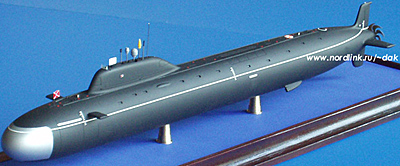 http://www.nordlink.ru/~dak/images/submarines/885.jpg
http://www.nordlink.ru/~dak/images/submarines/885.jpg
This model of the type 885, prototype design designation “Yasen”, NATO appellation “Granay”, the first example of which Severodvinsk, was finally launched after almost a decade of delay and indecision (it was laid down in January of 1993), represents the latest, and most lethal, Russian attack sub in commission today. It is rated as a Nuclear Submerged Cruiser, (1st Rank), and the same designation as for the Akula’s, for which this appears to be the replacement. Model image courtesy of Pomorsky Souvenir.
Dimensions are 364.2 x 39.4 x 27.6 feet, displacement 11,800 tons submerged. With a crew of 50, the Severodvinsk, carries 8 VLS tubes for cruise missiles, 4 25.6 inch torpedo tubes for which she stores 24 torpedoes and/or mines as well as RKP-55/SS-N-21 Granat/Sampson strategic cruise missiles. A total of seven were proposed, but it is uncertain how many will see completion.
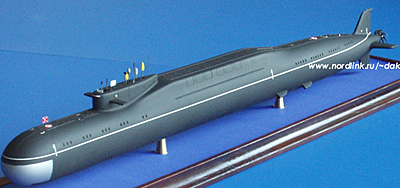 http://www.nordlink.ru/~dak/images/submarines/955.jpg
http://www.nordlink.ru/~dak/images/submarines/955.jpg
Here is Pomorsky Souvenir’s 1:200 model of a Type 955 strategic nuclear missile submarine.
It was planned that this new submarine would be 5 meters shorter that Typhoon, but longer than all other Russian SSBNs. Its configuration would be similar to Delta class subs. Due to financial shortages and other reasons Yuri Dolgoruky will not be completed until 2007. Dimensions are 557.7 x 44.3 x 29.5 feet
As noted earlier, the pace of SSBN construction in the 1990s has been wholly inadequate to the Russian Navy's needs. This model represents the sole new SSBN laid down over the course of the past decade, the prototype 4th-generation Project 955, whose construction officially began on 2 November 1996 in Severodvinsk, after nearly a decade-long break in SSBN construction. Although the Russian Navy had hoped the construction would take no more than four years, constant shortages of funding and problems with the development of a new SLBM intended for the submarine meant the expected 2002 entry into service has been postponed. Construction cost of a single Borey-class submarine has been estimated at $1.5 billion.
As an example of how the Russian Navy has had to pass the collection plate among civilian sponsors, Moscow Mayor Yuriy Luzhkov has provided some funds for its construction out of the city's budget. The ship was reportedly only 47% complete in May 2000, some four years after the start of construction. Russian Navy Chief of Main Staff Admiral Viktor Kravchenko blamed the slow pace of construction on inadequate funding. Another complication is that the sea-launched ballistic missile (SLBM) originally planned to be carried by this sub was cancelled, so a new missile must be substituted.
Kilo class submarine, Project 877. (From Pomorsky Souvenir)
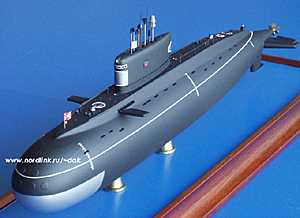 http://www.nordlink.ru/~dak/images/submarines/877.jpg
http://www.nordlink.ru/~dak/images/submarines/877.jpg
This model, like that of the Akula, shown above, is quite rich in surface details atypical of contemporary sub models. Note the guide railings on the deck for crew safety while running on the surface, hatch covers periscopes and radio antennae, silver sensors on the hull and sail surface and even the doors on the sides of the sail. .
The Russian Kilo Class submarine first entered service in the early 1980's. It was designed by the Rubin Central Maritime Design Bureau, St Petersburg. Subsequent developments have led to the current production versions, the Type 877EKM and most recently, Type 636. The submarines are constructed at the Admiralty Shipyard in St Petersburg. Twenty-four Kilo Class submarines are in service in the Russian Navy (most of the older designs). They have also been exported to Iran, China, India, Poland, Romania and Algeria. China has two Type 877EKM, Iran has three Type 877EKM and India has nine Type 877EKM. A tenth vessel for India, INS Insushastra, has been launched. The Type 877EKM is designed for anti-submarine (ASW) and anti-surface ship (ASuW) warfare
The third-generation submarines of Project 877 (Kilo class) and their export versions 877E and 877EKM were developed under a fundamentally new concept using newly developed equipment and construction techniques. The submarine was equipped with a one-shaft electric propulsion unit, combined with a standby propulsion plant arranged in the boat's aft end. The submarine's state-of-the-art electronics made the boat one of the most modern ships. The submarine's versatility is worth noting. It shows excellent maneuverability in shallow waters, straits and narrow passages, and performs well in any sea state.
Many navies worldwide recognize the Kilo-class diesel submarine as the most successful boat in its class because of its low level of generated noise (contributing to the submarine's enhanced stealthiness), impressive combat capabilities, reliability, excellent sea-keeping qualities, reasonable automation, easy operation and maintenance and high degree of survivability. Although this sounds like a sales pitch, or one of the bombastic boasts so favored by the late Soviets, the sub has proved to be a real asset to “Third World” customers.
Today, the navies of India, Algeria, Iran, Poland, Romania and China collectively operate 17 submarines of Project 877EKM. These submarines considerably enhance the combat efficiency of the navies of the countries that operate them.
Further development of the Kilo class boat resulted in a derivative diesel submarine, Project 636. By adding only two frame spacings (for a total of about four feet) to the boat's hull length, the designers increased the diesel-generator's power rating 1.5 times. The increased length also allowed them to furnish better shock-mounts for these enhanced generators and, consequently, reduced the generated noise level, reduced the main propulsion motor speed by half, and replaced over 30 items of equipment with the new low-noise models. Due to these changes the boat's underwater speed was increased to 20 knots, her acoustic field was reduced, and other parameters were improved. The submarines of Project 636 entered service with the Russian Navy over seven years ago. The first boats have already been exported.
The original Kilo 877-export version seems capable of considerable built-in upgrade potential. Among new equipment items that the Russian shipyards are offering to install in existing subs are towed transducer arrays, periscopes fitted with a night vision channel and laser range finder, an anti-ship cruise missile system, an air-independent fuel cell propulsion plant, etc. The submarine designers have shown a willingness to install equipment manufactured by other countries. With these upgrades, it is anticipated that the Kilo-class submarines will remain active through the first decade of this century.
According to Pavlov’s updated guide to Soviet and Russian warships, the Kilo was designed around a centralized computer that not only provides firing data for all the weapons systems, but also navigates the sub. However, this system requires careful crew training in order to function effectively. The Chinese have complained to the Russian supplier that these subs do not perform their tasks effectively. The Rubin Design Bureau executives have countered that the Chinese are having problems not because of any defect in the sub’s design but because they did not set up proper training facilities and programs. They pointed out that India seems to be quite satisfied with their 10 Kilos - which have been upgraded and modernized in Russia over the past couple of years.
The Kilos are so silent when transiting submerged (up to 400 miles), they are sometimes referred to as the “black hole in the ocean”. The aggressive Russian export program inspired the 1998 novel by noted naval fictionalist Pat Robinson, “Kilo Class”. In the novel, the Pentagon is alarmed at the incipient shipment of ten Kilos to China (at that time two had been authorized) which, in their estimation, would effectively bar the US Navy from the Taiwan Straits and clear the way for the Chinese reclamation of Taiwan. American subs and Seal units are sent to destroy the Kilos as they make their way to China. It is questionable whether the Kilos could actually pose such a grave threat to American naval power, but the scenario is intriguing nonetheless and an informal endorsement of the Kilo’s reputation.
Peter the Great and Frunze, battlecruisers
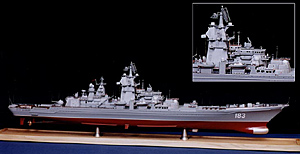 http://www.shipmodels.ru/images/peter_the_great/peter_the_great2.jpg
http://www.shipmodels.ru/images/peter_the_great/peter_the_great2.jpg
This 1:200 scale model represents most likely the most powerful surface warship roaming the world oceans today, especially considering that the two still existing Missouri class battleships of the United States Navy have been de-commissioned after serving in four wars. The model measures over four feet and two inches in length.
Now look at a sister ship, modeled in 1:1000 scale, just over 10 inches long (notice the pen alongside for comparison). If one considers that the foremost commercial manufacturer of warships in the comparable 1:1250 scale, the German company Navis/Neptun, cannot come close to this level of detail, one can understand the $3000 asking price.
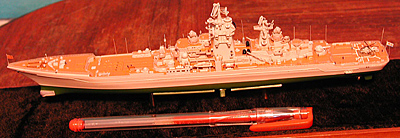 http://www.shipmodels.ru/images/frunze/frunze3.jpg
http://www.shipmodels.ru/images/frunze/frunze3.jpg
This kind of precision matches that found in the Peter the Great model, six times its size. How often can one find ladders with handrails in a model where one inch is the equivalent of 83.3 feet? Even though the premier 1:1250 scale manufacturer of merchant ships and passenger liners, Carat/Classic Ship Collection likewise includes such fine details, if you look closely at the latter’s models, you can see that the railings, windows and other such minutiae are too large for the scale. In these models everything is proportionate. This model won the gold medal for 1997.
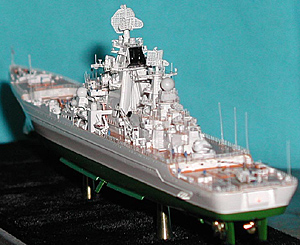 http://www.shipmodels.ru/images/frunze/frunze2.jpg
Following the commission of the Pyotr Veliky nuclear missile cruiser to Russia's Navy, Baltiisk shipbuilding plant (the same outfit that built the Krivak IV/Talwar frigates for India, described below) completed a series of four heavy nuclear missile cruisers of the Project 1144 (with improvements implemented during construction) developed by the Severnoe Design Bureau team. These ships can continually maintain contact with enemy task forces and outfight them. They are intended for operations either within task forces or alone in remote ocean regions. Their configuration permits them to destroy enemy nuclear missile submarines and surface ships, enhance the combat capability of naval forces in their vicinity, escort convoys and landing ships during their transit to landing areas and provide firepower to support the amphibious assaults. The following inventory of weapons suites will give a rough idea of this one-ship-navy’s authority.
http://www.shipmodels.ru/images/frunze/frunze2.jpg
Following the commission of the Pyotr Veliky nuclear missile cruiser to Russia's Navy, Baltiisk shipbuilding plant (the same outfit that built the Krivak IV/Talwar frigates for India, described below) completed a series of four heavy nuclear missile cruisers of the Project 1144 (with improvements implemented during construction) developed by the Severnoe Design Bureau team. These ships can continually maintain contact with enemy task forces and outfight them. They are intended for operations either within task forces or alone in remote ocean regions. Their configuration permits them to destroy enemy nuclear missile submarines and surface ships, enhance the combat capability of naval forces in their vicinity, escort convoys and landing ships during their transit to landing areas and provide firepower to support the amphibious assaults. The following inventory of weapons suites will give a rough idea of this one-ship-navy’s authority.
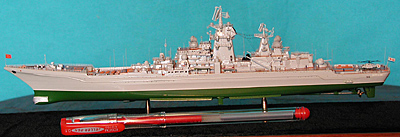 http://www.shipmodels.ru/images/frunze/frunze4.jpg
The firepower of the cruiser is enhanced by 20 underdeck missile launchers to fire cruise missiles with significant accuracy against enemy large surface ships within task forces at a range of over 500 km. The ship fire-control system fed with data from the target designation complex can guide launched missiles throughout the full extent of their firing range. The cruiser is able to maintain its strike potential via sophisticated anti-aircraft defense (AD) armament. The armament comprises two versatile missile systems, Riff type, with underdeck drum type launchers for vertical launch of AD medium-range missiles. The AD guided missile can destroy any type of high speed maneuvering air targets at altitudes ranging from 25 meters to 30 km and at a distance from the ship of up to 90 km. A secondary battery of AD missiles can engage various air targets at a range of up to 1.5 - 12 km. Additionally there are cruiser air-defense and antimissile defense system encompassing two Kashtan type missile-artillery systems, each of which consists of a detection radar, one command and three combat modules. The system is regulated by an integrated control system, with different channels for simultaneous tracking of targets and missiles in radar and TV-optical modes and full automation of the combat control process, ranging from target detection to destruction. The missiles delivered in transporter-launcher containers can hit targets at a range of up to 8 km and 30mm automatic guns up to 5 km at maximum low flying targets and targets flying at a 4-km altitude.
http://www.shipmodels.ru/images/frunze/frunze4.jpg
The firepower of the cruiser is enhanced by 20 underdeck missile launchers to fire cruise missiles with significant accuracy against enemy large surface ships within task forces at a range of over 500 km. The ship fire-control system fed with data from the target designation complex can guide launched missiles throughout the full extent of their firing range. The cruiser is able to maintain its strike potential via sophisticated anti-aircraft defense (AD) armament. The armament comprises two versatile missile systems, Riff type, with underdeck drum type launchers for vertical launch of AD medium-range missiles. The AD guided missile can destroy any type of high speed maneuvering air targets at altitudes ranging from 25 meters to 30 km and at a distance from the ship of up to 90 km. A secondary battery of AD missiles can engage various air targets at a range of up to 1.5 - 12 km. Additionally there are cruiser air-defense and antimissile defense system encompassing two Kashtan type missile-artillery systems, each of which consists of a detection radar, one command and three combat modules. The system is regulated by an integrated control system, with different channels for simultaneous tracking of targets and missiles in radar and TV-optical modes and full automation of the combat control process, ranging from target detection to destruction. The missiles delivered in transporter-launcher containers can hit targets at a range of up to 8 km and 30mm automatic guns up to 5 km at maximum low flying targets and targets flying at a 4-km altitude.
In addition to AD missile systems, the cruiser is also fitted with the AK-130 multi-purpose gun system to ensure self-defense against low flying anti-ship missiles. This is similar to the American Phalanx anti-missile defense array. The cruiser's 130mm-twin gun mount is intended to deliver fire against sea and coastal targets and furnish fire support for naval landings. The heavy guns utilize several types of rounds with impact, proximity and radio fuzes. The MR-184 fire-control system can track and engage two targets at a time. To protect the cruiser from enemy fire, including missiles, the armament system comprises electronic counter-measures equipment coupled with a passive jamming system. Radar and optronic projectiles associated with the passive jamming apparatus dispense decoys, thereby reducing the effectiveness of enemy missiles directed against the cruiser.
The Pyotr Veliky cruiser's antisubmarine system is configured as follows: advanced sonar equipment with an underkeel antenna (in a bulbous fairing and a towed array; adaptable missile-torpedo armament system, including 533mm launchers (five on either side) housed in the cruiser's hull and capable of delivering fire via side ports; an RBU-1200 ten-barreled launcher and two RBU-1000 six-barreled launchers. The cruiser accommodates two Ka-27 antisubmarine helicopters stowed in an underdeck hangar, magazine for aircraft ammunition load, lift and helicopter pad for takeoff and landing.
The cruiser is fitted with the Flag type radar system, including radars with integrated primary processing of data received from detected targets. The cruiser’s automated combat control complex is served an information management system. The cruiser navigation aids serve both combat and routine tasks.
Stand-by steam boilers develop 17 knots in the event of a nuclear reactor shut-off and ensure an operational range of up to 1,000 miles in that event using shipborne fuel. Janes’ gives the range of the ships as 14,000 miles at 30 knots, a shade below full steam (32 knots) with all systems working, including the nuclear powerplant. The ship can remain at sea for two months without replenishment.
Kiev, helicopter and STOL aircraft carrier
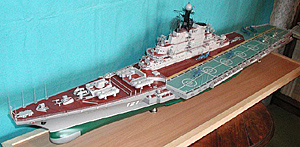 http://www.shipmodels.ru/images/kiev/kiev2.jpg
http://www.shipmodels.ru/images/kiev/kiev2.jpg
This picture of the Ship Model Club of St. Petersburg’s Kiev in 1:200 scale gives an idea of the 4 1/2 foot length of the model. Perhaps a bit large for a small office or a little study in a home but it would perhaps grace the boardroom of a naval institute or the library of a naval history department in a university. Compare this level of detail to that achieved in the model of the sister ship, Frunze, at 1/5th the size.
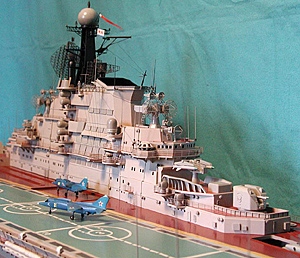 http://www.shipmodels.ru/images/kiev/kiev5.jpg
http://www.shipmodels.ru/images/kiev/kiev5.jpg
This view of the Kiev model clarifies why carefully made models can be wonderful tools for learning about ship design. It is often difficult to get good multi-level perspectives on a ship’s systems while touring the actual vessel - one is too close to the several parts and loses sight of the aggregate. The photos released by the various navies might not be from the best perspectives nor are they often of high quality. Also, in scales smaller than 1/16th inch = 1 foot, which is roughly the scale of this model, the aircraft are so small that they may appear as indistinct little bumps on the flight deck. Here one can appreciate the positioning of the planes and distinguish among the several types.
Work on the development of an improved version of the Moskva class, the Project 1143 Krechyet antisubmarine cruiser, was initiated in 1967. The bulk of the ship's armament was made up of 36 Yak-36M airplanes and Ka-25 helicopters. The Project 1143 cruisers, unlike that of the predecessor Project 1123 (the Moskvas) , carried the long-range P-500 Bazalt anti-ship missile system featuring eight reloadable launchers. The superstructure of the ship was shifted to the side and provision was made for an angular flight deck. These ships displaced over 41,000 tons and in compliance with the new ship classification system introduced in the Soviet Navy, they were categorized as heavy aircraft carrying cruisers. Note that neither this ship nor its immediate follow-ons were devised as the equivalent of the US aircraft carrier.
The Project 1143 type ship named Kiev was laid down in Nikolayev on July 21, 1970 and was commissioned in 1975. The second ship of the project (named Minsk) was built in 1977. In compliance with the new ship classification system introduced in the then-Soviet Navy, these ships were categorized as heavy aircraft carrying cruisers. The navy collaborated with shipbuilding industry specialists on the early projects, embracing ships designed for carrying helicopters and VTOL airplanes. The designers regarded them as preliminary steps that were required to develop ships capable of carrying conventional aircraft possessing performance characteristics much superior to those of the VTOL aircraft. The development of the first ship in this class was stipulated in the 1971-1980 ten-year military shipbuilding plan approved in 1969. In the early 1970s, the shipbuilding industry began conducting comprehensive research work laying the foundation for the creation of air-capable ships. In 1972 the Nevskoye Planning and Design Bureau worked out a conceptual design of the Orel aircraft carrier.
This became the Kuznetsov Class heavy aircraft carrying cruiser, also known as Project 1143.5 or Orel Class. The Admiral Kuznetsov was launched in 1985. A second vessel of the Kuznetsov class, the Varyag, was launched in 1988 but was never commissioned. Admiral Kuznetsov remains the only true aircraft carrier in the Russian Navy. The hull design is based on the earlier Admiral Gorshkov, launched in 1982, but it is larger with a full load displacement, 58,500 tons as compared to 40,400 tons for the Gorshkov. The Admiral Kuznetsov’s mission is to support strategic missile carrying submarines, surface ships and maritime missile-carrying aircraft of the Russian fleet. As of this writing, the proposed deployment of the Kuznetsov was cancelled. Admiral Gorshkov has not been operational since 1988 and negotiations were underway for a possible sale to India. The Indians were offered a sweet deal, in which all they had to do was modify the ship to carry their own aircraft at their expense and the Russians would make a gift of the ship. This writer does not know the outcome of these negotiations.
Krivak IV /Talwar frigates
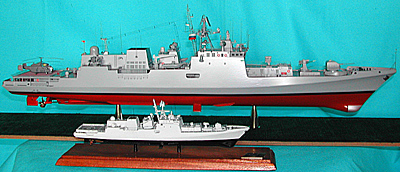 http://www.shipmodels.ru/images/talwar/new_talwar_twin1.jpg
http://www.shipmodels.ru/images/talwar/new_talwar_twin1.jpg
In the background is a large, 1:200 scale model of the Krivak IV/ Talwar class frigate, while the smaller model in the near view is a 1:500 scale representation of the same ship. The 1:200 scale model is just over two feet long, whereas the more petite sister measures only 10 inches without the base. The author purchased the smaller model based upon economies of cost and space. While it would be possible to add much more detail in the 1:500 scale the price could thereby increase five-fold. See the model of the Frunze battlecruiser above to see what can be done in 1: 1000 scale, if one has $3000 in spare change and can swing it. The 1:500 model purchased by the author was created by Sergey Alexandrovich Shlichkov
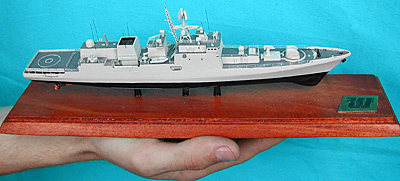 http://www.shipmodels.ru/images/talwar/new_talwar5.jpg" align=right hspace=3>
http://www.shipmodels.ru/images/talwar/new_talwar5.jpg" align=right hspace=3>
Here is a closer view of the smaller model. You can see that the general shape and characteristics are adhered to, but the model is best when seen from a few feet away, since one would expect the human-scaled features to be visible from the sailor’s eye view. Nonetheless, it is a well-executed model within its limitations of size, scale and price.
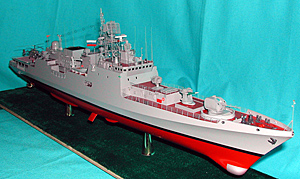 http://www.shipmodels.ru/images/talwar/new_talwar2.jpg
http://www.shipmodels.ru/images/talwar/new_talwar2.jpg
Another view of the bigger model, showing the extent of exact duplication down to the rigging, latticework on the antennae, hatch cover latches - things that would normally be apparent only to someone walking the decks.
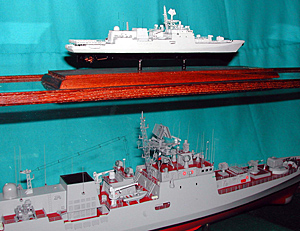 http://www.shipmodels.ru/images/talwar/new_talwar_twin7.jpg
http://www.shipmodels.ru/images/talwar/new_talwar_twin7.jpg
Another comparison of the two versions side-by-side. The large model won the 3rd place in the championship contest for all Russia. The ship was built at Baltiisky Zavod shipyard in St. Petersburg for the Indian Navy and was given the name "Dozorniy" while it was undergoing sea trials. It was turned over to the Indian forces in June 2002 and named Talwar.
This photo of the larger model gives an idea of why models can enhance one’s appreciation for their subjects. It would be difficult to find a photo taken from this vantage, unless the ships were in dry-dock and even then, the big picture would be obscured by the scaffolding. Also one can admire the beauty of this design from a wholly artistic perspective. The Krivak IV Project 1135.6 design has rightly been nominated as one of the most aesthetically pleasing modern warship designs in existence, rivaling many of the handsome Italian designs and the clean-cut MEKO class of NATO frigates in that respect. Some of the utilitarian modular boxes and stark stealth designs appear clunky or slab-like in comparison. The Talwars, along with the all-powerful Kirovs, epitomize what a contemporary warship should look like.
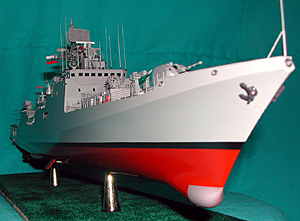 http://www.shipmodels.ru/images/talwar/new_talwar4.jpg
http://www.shipmodels.ru/images/talwar/new_talwar4.jpg
Besides the highly evolved Project 956E destroyers, 17 examples of which were built and turned over to the Russian Navy since 1997, the estimable Severnoye Design Bureau has taken the lead in designing frigates for export. The elevation of frigates to the main striking arm of many countries’ naval development programs (given the fact that destroyers are too costly and are overmatched to the likely threats) means that they must evolve into multi-mission ships. This task is accomplished by arming them with state-of-the-art weapon systems that can effectively engage surface ships, submarines, air and shore-based targets, and backing this firepower with multi-task surveillance and target designation systems.
Krivak
On the basis of this concept, the bureau devised an export version of a frigate, finding great potential in the excellent Krivak design dating back to the late 1960s. Ships of the basic project (Project 11351), built for the Russian Navy, were endowed with expandable combat capabilities, excellent seagoing qualities, and a low noise signature, and are easy to operate. The engineering innovations used in these ships and their great potential for modernization served as a basis for the export-oriented Project 11356 frigate. Their modern weapon systems consist of: the Klub-N vertical-launch strike missile system, Shtil-1 medium-range antiaircraft missile system, the Indian-designed Kashtan gun/missile system, A-190 100mm gun mount, DTA-53 torpedo launchers, RBU-6000 rocket launchers, and a helicopter. The slight increase in its displacement is due to the installation of the heavier armament and the replacement of light-alloy structures with steel ones.
Krivak I’s and II’s had created quite an impression on NATO naval planners when they were first encountered in the early 1970s. Their evolution into the Krivak III and ultimately the outstanding Krivak IV/Talwar is a Cinderella story. The Russian navy seems not to have realized the true potential of these durable warships until their only customers were foreign navies.
Conceived in the late 1960s, Project #1135 Burevestnik [Krivak I] was an entirely fresh project, rather than an evolved/modified variant of an earlier class. Western analysts initially believed the Krivak was designed for offensive surface warfare. In reality, the class was intended primarily as a defensive anti-submarine warfare ship. The Krivak was designed as a less expensive and capable counterpart to the larger Kresta II and Kara classes, with which it originally shared the BPK (large ASW ship). In the late 1970s the designation changed to SKR (Storozhevoy Koabl') or small antisubmarine ship, or literally “patrol rocket-launching ship” , a more accurate indication of their actual capabilities. The Project #1135M Krivak II, 11 units of which were competed between 1975 and 1982 mainly differs from the initial version in having a different caliber gun.
In 1982 a joint Resolution of the Ministry of Shipbuilding Industry and the Navy approved the development of the Project 1135 and Project 1135.1 escort ships, based on new design and operation requirements for advanced AA/ASW, radio and radar equipment with a strike capability against surface ships. At the same time the Project 1154 class (to become known as Neustrashimy) with a similar displacement, was focused on combating submarines and was intended to provide antisubmarine, antiship and antiaircraft defense to surface ship task forces and convoys. The Project 1135.1 Nerey [also reported as Project #1135P] Krivak III class was initially constructed for the now defunct KGB Maritime Border Guard, (functionally corresponding to the US Coast Guard). The Krivak III’s have seemingly been transferred to the Russian Navy, under the Project 1135.5 designation. The Krivak-III also features 100-mm gun that replaced the SS-N-14 ASW missile launcher found on other models. Although having less ASW capability than the Krivak-1/II, they accommodate a utility helicopter protected with a permanent afterdeck hangar. If the Kamov KA-28 anti-sub helicopter rather than the recon version is embarked, then the so-called antisub deficiency is surmounted.
Two Krivak III units were transferred to Ukraine prior to completion. Some naval authorities believe the downgrade of the Krivaks from the original anti-submarine oceangoing category to “patrol vessel” in KGB Border Guard use, is indicative of their relatively short endurance at sea. This may have been true of the Krivak II model, but advances in the all- gas turbine reduction geared COGOG power train have increased the range from about 3,000 miles to 4000 at 14 knots furnishing longer “sea legs” to cover most of the maritime approaches. All indigenous Russian Krivaks have been decommissioned already or soon will be deactivated as the Neustrashimy class frigates come on line.
The 4,000-ton Krivak IV frigate underwent engine trials in Finnish Bay for three weeks before beginning comprehensive running and firing trials at the Russian Baltic Fleet base near Kaliningrad. Russian officials handed over the ship to India in June 2002. The other two were expected to follow in intervals of six months.
The contract for the ships was signed in 1997. India is paying $1 billion for them. They are improved versions of the Russian Krivak III class frigates with extensive design modifications carried out by Indian naval architects making the ship essentially a new design, the Krivak IV. Thus the occasional designation “modified Krivak III” is faulty The ships incorporate stealth characteristics, although are not “stealth frigates” per se. They are armed with the 300-km range Klub cruise missiles that can be configured to carry nuclear warheads, Kashtan air defence guns, the Shtil-I multiple-barrel rocket system and the 100mm A-190 automatic guns firing 80 rounds a minute. These guns are especially effective against aerial, sea-borne and land-based targets. Each frigate accommodates a KA-28 anti-submarine warfare helicopter with an on-deck hangar.
The Krivak IV [Project 1135.6], sometimes incorrectly labeled as “Krivak III improved”] was intended solely for export, with the same general layout as the Krivak III, though with enhanced electronics and weapons. It would seem that Russia was already fulfilling the mission and capabilities of this export Krivak with their Neustrashimy. A bit of clarification is useful here, since the Krivak IV and the slightly larger Neustrashimy seem to overlap. The latter are a new, modern, relatively heavily armed multi-role frigate design. Primarily intended as an anti submarine warfare ship, but potentiality for modern surface to surface missiles confers an anti-surface warfare capacity; the SSMs, however, were not fitted at completion, probably due to funding problems. The design incorporates some stealth features. The Neustrashimy’s were completed in 1989 but not commissioned until 1993. They originally were proposed as a successor to the much smaller (1000-ton) 'Grisha' class corvette, but the design grew and they have essentially become successors to the 'Krivak' line. Only one unit was completed; two others were started but were apparently scrapped incomplete. Their classification is probably that given the downgraded Krivaks in the late 1980s -- Storozkevoy Korabl' (SKR) or Patrol Ship.
The first Talwar-type frigate for India was laid down at the Baltiisky Zavod shipyard in St. Petersburg in March 1999, was afloat by mid 2000 and commissioned in June 2002. The Baltiisky Zavod is building the second frigate, and the third frigate was laid down at the end of May 2000. As noted, the Talwar-type frigate is a further development of the Project 11351-patrol ship concocted by the Severnoye Design Bureau. Ships of this type were initially built for limited coast guard forces, with capabilities to patrol out to the 200-mile offshore zone.
The Krivak platform was correctly perceived as meritorious and capable of bona fide oceangoing missions. Accordingly the design Project 1135.6 frigates differ from Project 1135.1 patrol ships in the range of tasks they can perform and in the assortment of weapon systems. The latter include the Club-N missile system recently developed by the Yekaterinburg-based Novator Design Bureau. The Talwar-type frigate carries the Club-N system’s eight standardized vertical launch tubes that are installed in front of the pilothouse. Another missile system, Shtil, installed closer to the bow, is intended to combat air targets at a range of 3 to 25 km. Its ammunition load comprises 24 missiles. Length overall is 313 feet and displacement, ranges from 3850 to 4000 tons. Range with the enhanced COGOG system is 4,600 miles at 20 knots, full speed being 32 knots. The COGOG designation means “combined gas OR gas turbine”. This confusing label simply connotes that there are two gas turbine generators coupled to the drive train in a manner so that only one is engaged for economical extended range cruising while both are brought on line to achieve flank speed. The ships can remain at sea for up to 30 days without replenishment. The addition of modern fin roll-stabilization is further indication of the frigates’ “blue water” aptitude. These are truly oceangoing ships, as the Indian Navy’s extensive sea defense perimeter demands.
These vessels are designed primarily for anti-submarine warfare and for the air defense of warship task forces. The Indian Navy requisitioned the ships in order to fill the gap created by the decommissioning of the British built Leander Class frigates in advance of the commissioning of the first of the Project 17 Nilgiri Class frigates, an enlarged and modified version of the Russian Project 1136. These Talwar frigates, upgraded to destroyers in Indian use due to their versatility (especially the local area-defense Kashmir SAM), are said to be the first Indian Navy warships to incorporate stealth technology. The official Indian line is that “plans to acquire another three vessels of the (Talwar/Krivak IV) class are unlikely to occur, as priority is being given to construction in India of the indigenous Project 17 Class frigates.” Given the over-optimistic time frames projected for previous domestically licensed ships, however, it seems likely that the Talwar class will have to suffice through the first decade of the 21st Century. That is not a bad thing, because the Talwars appear quite capable of engaging and destroying the PAK navy’s most worrisome recent acquisition, the French-built Agosta B subs before the latter’s torpedo and Exocet missile systems come into range. The PAK surface force has nothing to match the Krivak IV.
It is true that there is no indication that the Russian Navy is a potential customer for further units of this class. Their equivalent of this model may be the Project 1154 Neustrashimy class frigate. There is some confusion on this point, however. Project 1154 was built at the Yantar Shipbuilding Plant in Kaliningrad, Russia. The first of class ship, the Neustrashimy was commissioned in 1993. Two more ships have been launched - Yaraslavl Mudry, in 1991 and Tuman in 1993. The Neustrashimy design, according to some sources, contemplated a slightly larger offshoot of the Krivak class.that were built between 1969 and 1993. It certainly appears to be the case.
The Talwar is likewise an improvement on the earlier Krivaks. One wonders, then, why the Indian Navy did not simply order the Neustrashimy since it had already entered the production cycle and was a tested design.
Clearly the expert nautical model craftsmen and craftswomen of the Russian Federation will continue to produce stunning miniature warships that reflect the quality of their nation’s shipyards in generating great ships for export. Perhaps it may not be so long until these excellent warships might be flying the St. Andrews’ flag of Mother Russia.
More Great Ships in Search of a Navy Modern Russian Ships
- I: Soviet Naval Decline: Russian Retrenchment
II: Naval Review in Miniature
III: Ship Models, Significance, History, and Characteristics of Originals (monstrously slow)
NOTE: Jim Bloom's article uses a significant number of images in "III: Ship Models" pulled from elsewhere on the web. We chose to leave them in, despite the slowness of the download, because they are quite good. But be warned. It will take a while to download the entire section III and associated images. And we also warn that given the nomadic tendencies of web sites, these images may not necessarily be there in the future.--RL
Back to War Lore: The List
Back to Master Magazine List
© Copyright 2002 by Jim Bloom.
This article appears in MagWeb (Magazine Web) on the Internet World Wide Web.
Other military history articles and gaming articles are available at http://www.magweb.com